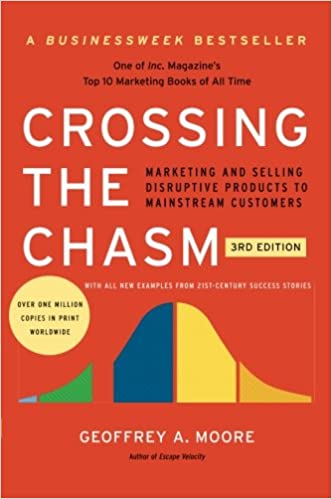OK I GIVE UP
Crossing the Chasm

Crossing the Chasm is referenced by pretty much every book on startups out there, and rightly so. Geoffrey Moore looks at the problem of creating a sustainable company from an initial technology and vision from a marketing perspective, which is usually lacking in new enterprises with an idea and some venture money. The author mentions in the introduction that some companies have Crossing the Chasm as required reading, which makes a lot of sense, because the book considers the complete enterprise, and not just the marketing department, in its discussion of how to cross the chasm.
So what is the chasm? Technology wants you to change, and people respond differently to this demand. The technology adoption lifecycle is a curve that classifies people based on their response, from innovators who try out everything to see whether they work, to visionaries (also called early majority) who expect quantum leaps from new technology, to pragmatists who want to make sure they get their money’s worth, to conservatives who switch to a new technology only when they have to. Moore urges the reader not to think that the transition of a technology company’s marketing strategy from one segment to the other is necessarily fluid and without existential risks. There are gaps between each segment, but the one between visionaries and pragmatists is the widest one, with many a promising company having fallen there and not managed to get back up. Even if a company has successfully marketed to the innovators and visionaries, becoming sustainable requires getting a foothold in the pragmatist segment, which in turn requires the mentality of the whole company to change. The reason for this is that visionaries and pragmatists look at different things when they are making buying decisions. Visionaries are looking for a new feature, something never possible before, that would give them an advantage over the others. Pragmatists, on the other hand, although they are also interested in new technologies, want to invest in a “whole product” with good references. The problem is then twofold: Visionaries are no references for the pragmatists, and the core product marketed to visionaries does not fulfill the demands of pragmatists. The gap opened by these two issues is the Chasm; Moore discusses the nature of this chasm in detail, and proposes ways to cross it.
The extensive depiction of the different marketing segments makes Crossing the Chasm and ideal book for engineers and developers who want to understand the different reasons their users adopt and use new technology, what they expect from the product in question, and what one can expect of them in return. Visionaries, for example, make great early users, because they can see past the faults of the product, filling in the gaps themselves, and providing detailed criticism. They do not make long term clients, however, because once the engagement is over, they will be looking for the next big thing. One of the lessons of Crossing the Chasm is that a company should be conscious of which segment it is marketing to and hone all of its efforts accordingly. One point Moore keeps on hammering is the importance of focus for companies operating in the chasm. Getting into the mainstream market is possible only if a very small niche is targeted and served to a satisfctory degree, and this is can be done only if all the resources of a fledgling startup are concentrated on this niche-conquering effort.
Crossing the Chasm is not without its flaws. One thing that irked me was how the book included examples from the B2C domain, but mentioned that crossing the chasm in B2C is very difficult, and not the focus of this book, pretty further into the text (p.96). Also, although the book has been updated once in the 90s rewritten once, the examples given are somewhat aged due to the nature of the high tech market (in which business was Sun, again?). Another point which had me thinking was how much of the marketing wisdom imparted by Moore applies to modern day online software, with Google keeping its products in perpetual beta, and most companies vying for other sorts of income than direct payments from the users. I wish someone wrote an extension to Crossing the Chasm that discussed these topics.